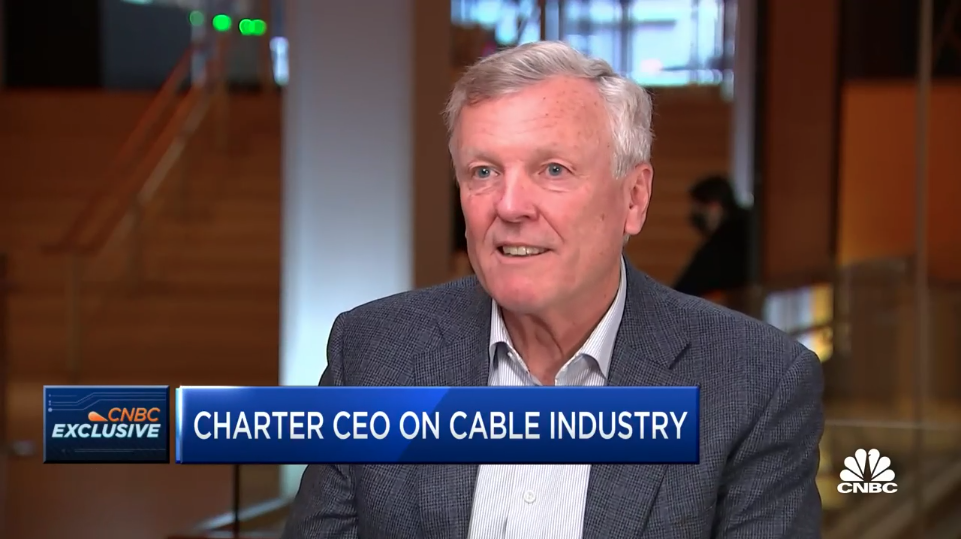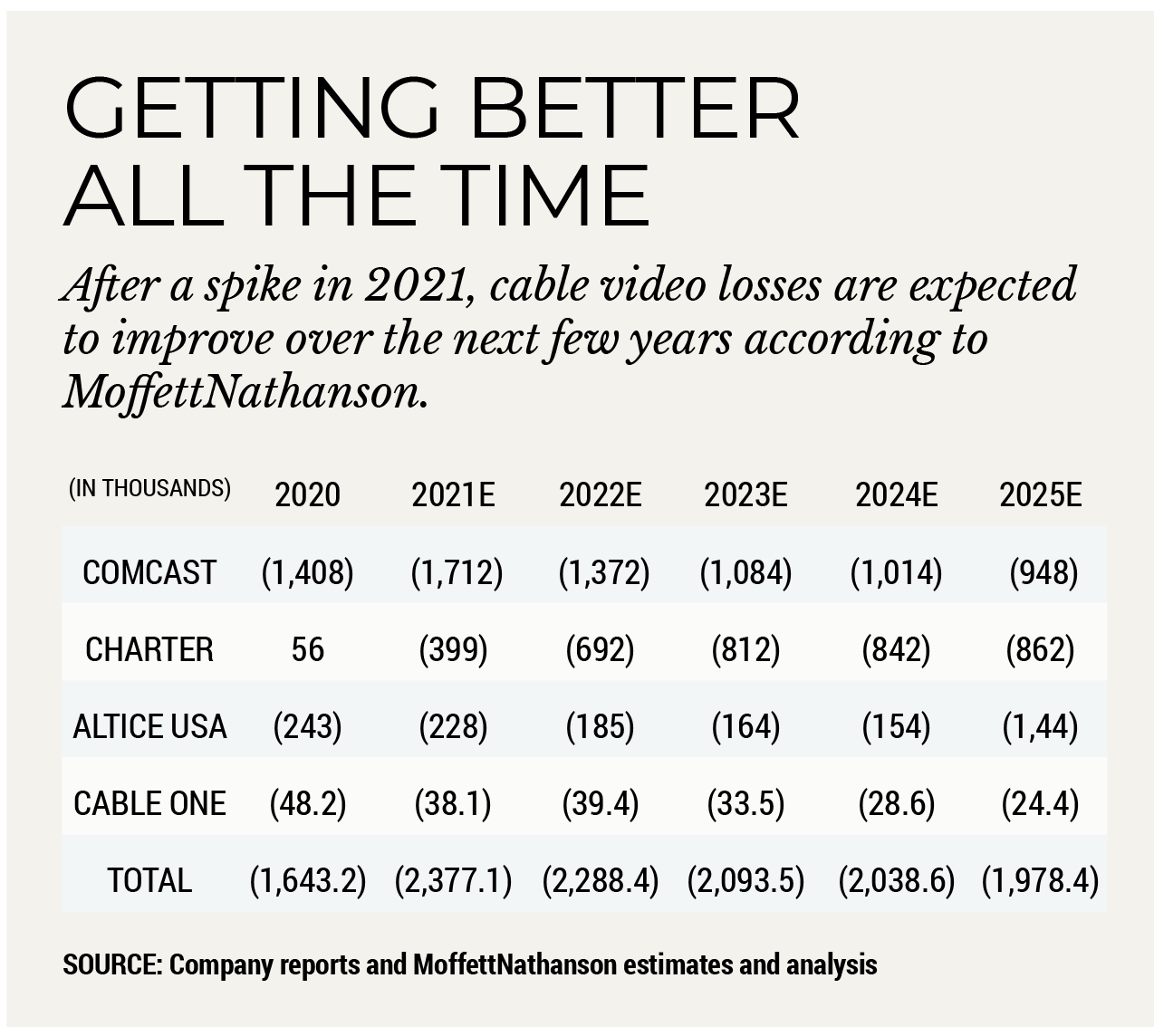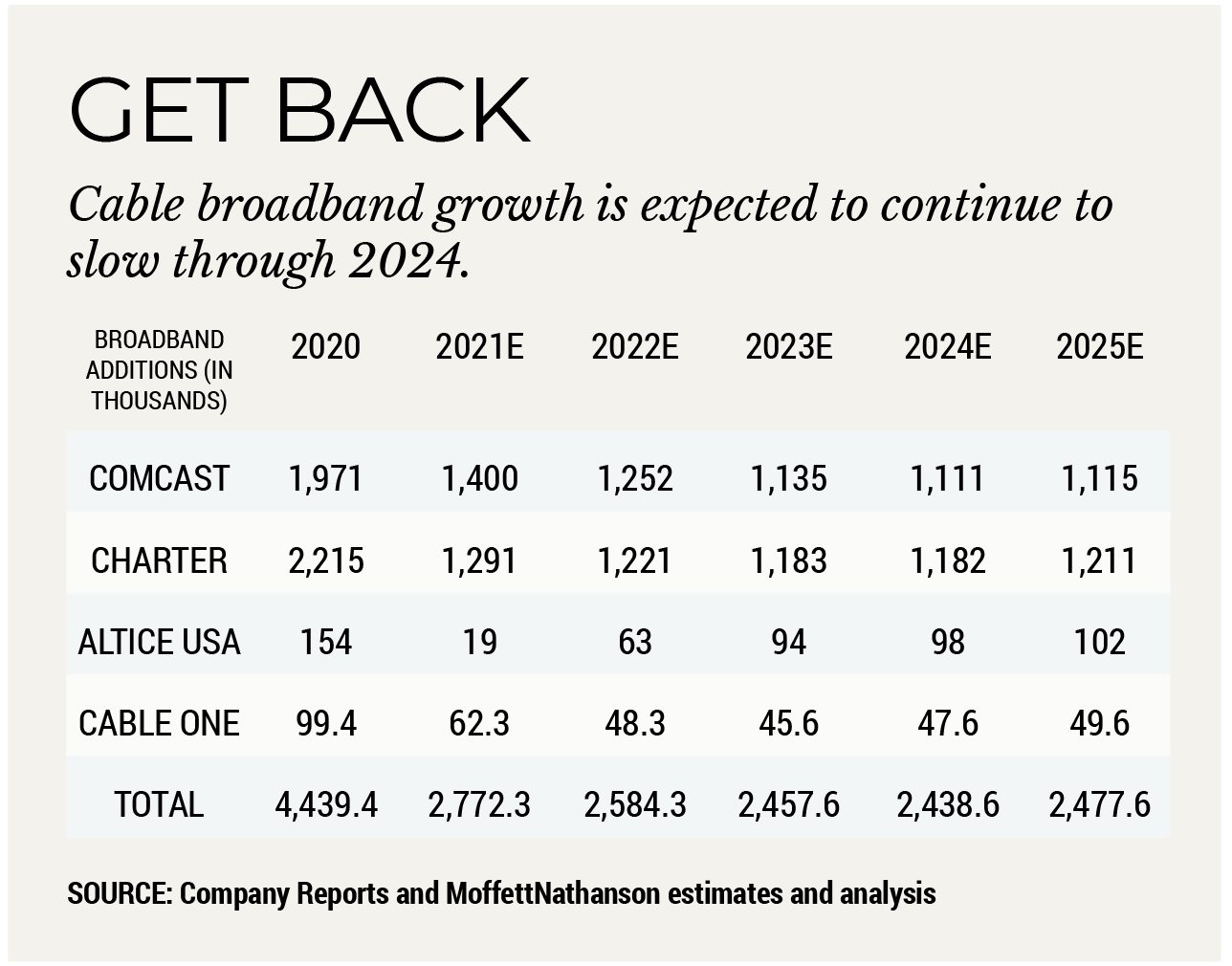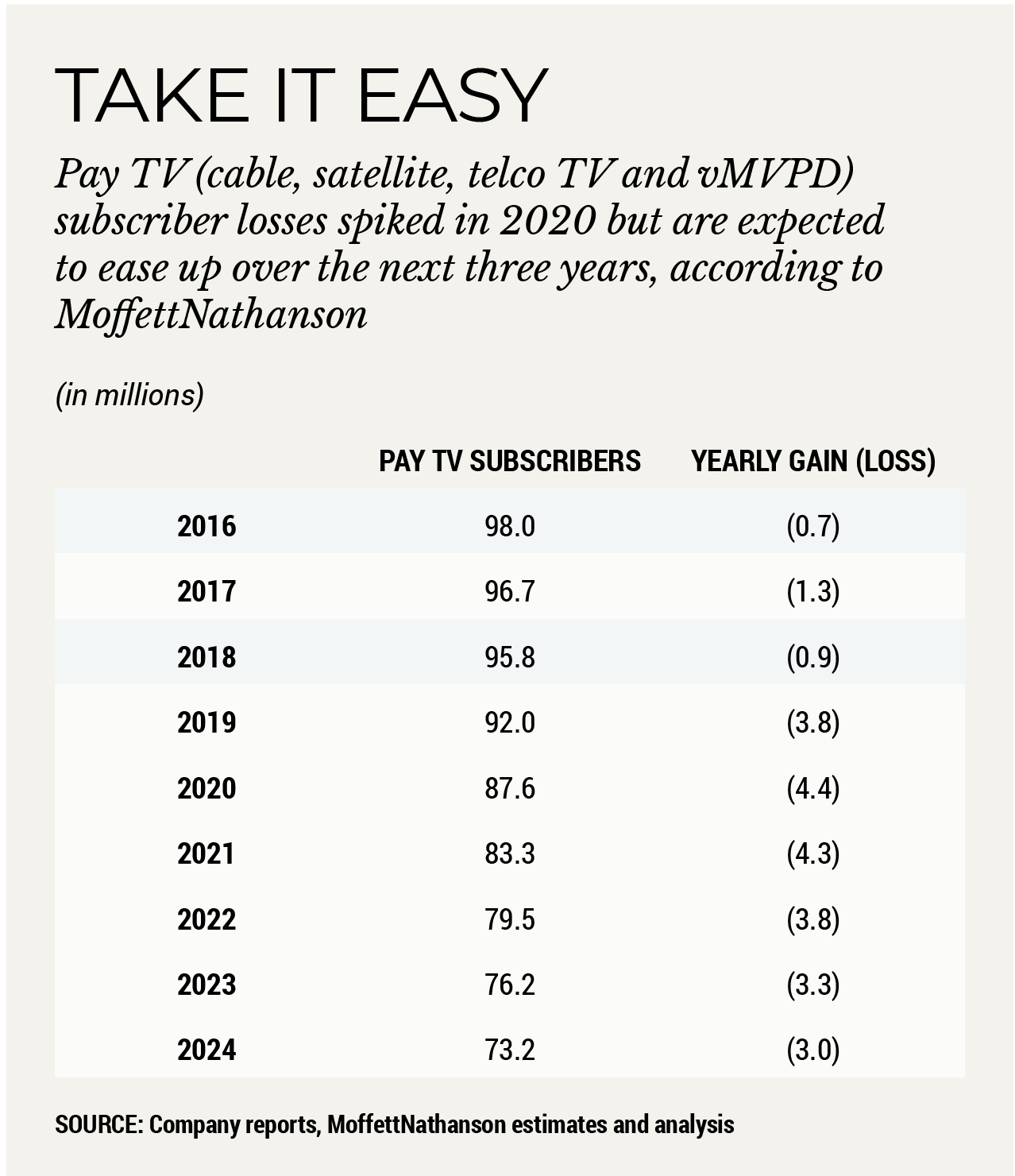Are Cable’s Video Losses Getting Better?
While broadband slippage was mostly as expected in Q3, video subscriber performance was bolstered by sports and favorable bundle economics. How long can it last?

As analysts scrambled to recalculate their year-end estimates for broadband subscriber growth after a worse-than-expected Q3, they might have to take out their calculators once again as video subscriber losses, once expected to accelerate as the year progressed, actually improved during the quarter and should continue that momentum for at least the next few years.
The severity of the slowdown in broadband subscriber growth took some analysts by surprise in Q3, forcing most to rejigger their estimates for full-year growth. But video losses, which should spike for cable operators to about 2.4 million in 2021, are expected to slow as well, to about 1.98 million in 2025, per MoffettNathanson. At the same time, pay TV subscriber losses in general are expected to temper to about 4.3 million for the full year, according to Wells Fargo Securities media analyst Steven Cahall. That’s better than the 4.7 million he estimated were lost in 2020 and is tied in part to subscriber apathy as well as a sense that as streaming services continue to increase their prices, the wired bundle isn’t such a bad value after all.
Over the past few months, streaming service Disney Plus raised its monthly rate to $9.99, up from $7.99 when it launched in 2018. Hulu Plus Live TV said it would raise the monthly price of virtual MVPD service by $5 beginning on Dec. 21, adding that subscribers would get access to Disney Plus and ESPN Plus included.
While no one suggests wireline video is making a comeback, its demise may not come as fast as first predicted. Cahall now sees pay TV subscriber losses reaching 4.7 million by 2024, while SVOD subscriber additions should decelerate from 5 million in 2020 to 1.3 million in 2024.
Video’s Transition Phase
In an interview with CNBC’s David Faber on Nov. 18, Charter Communications chairman and CEO Tom Rutledge said that while pay TV still has its problems, improving video subscriber growth shouldn’t come as a total shock.
“It’s a problem business in the sense that it’s a business in transition,” Rutledge said in the CNBC interview. “The cost of video has gotten really high ... It’s difficult from a pricing perspective to create value for a lot of customers. On the other hand it’s still the best product out there. … I think it’s still a business that we need to be in. I think it’s a value to our customers, [and] the rate of loss in the bundle will probably slow.”
Still, Rutledge said he sees the new “double play” bundled offering from cable as a broadband/wireless package instead of a broadband/video pairing.
Broadcasting & Cable Newsletter
The smarter way to stay on top of broadcasting and cable industry. Sign up below

Rutledge reminisced back to 2004, when as CEO of Cablevision Systems he launched a wireline telephony product to compete with the big telcos, which were charging as much as $72 per month for service. Now, wireline phone service is priced at about $13 per month and cable has the lion’s share of that market.
“The major share of that business has moved to our business,” Rutledge told CNBC. “I think mobile has a similar opportunity.”
Depending on the researcher, broadband subscriber growth was between 630,000 and 726,000 new customers in Q3 2021, about half the increases of the same period in 2020 but in line with the tally from the prior two years. Pay TV video losses, on the other hand, were at about -4.8%, better than the -4.9% of the prior year and on pace to reach 4.3 million for the full year (down 4.8%), a big improvement over the 4.7 million lost in 2020, according to Cahall‘s estimates.
While total video subscriber losses are on a path to improve this year, the question remains whether that pace will accelerate, decelerate or stay the same.
“It’s a tough dynamic to pick apart given the unknowns in large variables,” Cahall wrote in a note to clients. “We view potential price increases of pay TV bundles and how much incremental live content is heading to streaming either simulcast or exclusive as major swing factors.”
Sports a Leading Indicator
Cahall said sports could end up being the key determinator as to which way the video pendulum swings. So far, most major rights deals have adopted a hybrid approach to sports, with exclusive content on both linear and streaming platforms. At least for the near term it seems sports lovers will need pay TV for game content.
“We don’t think ESPN will house its premier content on DTC [direct-to-consumer platforms] anytime soon,” Cahall wrote. “Disney and the rest of its legacy media peers are for now striking the right balance of keeping enough content on linear to drive higher affiliate fees while adding incremental content on streaming on a selective basis.”


Cord-cutting has been talked about for years, but didn’t really take a bite out of linear TV until 2019, when pay TV (cable, satellite, telco TV and virtual MVPDs combined) lost 3.8 million subscribers, compared to just 900,000 in the prior year, according to MoffettNathanson. Video subscriber losses continued in 2020 when the industry shed about 4.4 million, a combination of the pandemic and an increase in the number of major streaming services.
MoffettNathanson agrees with Cahall that total video-sub losses should dip slightly to 4.3 million in 2021, and expects the slowdown to continue in 2022 (3.8 million losses), 2023 (3.3 million) and 2024 (3.0 million). In a research report issued on Nov. 30, MoffettNathanson saw access to sports and news programming as the deciding factors.
MoffettNathanson predicts that there will be about 73.2 million pay TV customers in 2024, but sees the segment bottoming out at about 53 million subscribers. That is the number the researcher, along with telecom consulting firm Altman Solon, estimated are news and sports junkies, the stickiest segment for linear pay TV. Just when that floor will be reached is anyone’s guess, but will largely be determined by when and where distributors move more sports and news content over-the-top.
Some networks already have begun to move some sports content to OTT — NBC’s Sunday Night Football is on Peacock and CBS’s NFL games are simulcast on that broadcaster’s streaming service, Paramount Plus — but that hasn’t been enough to force sports lovers to make the switch. MoffettNathanson estimated that while pay TV subscribers (including vMVPDs) have declined by nearly 9 million since 2019, regular sports viewers actually increased by 2 million during the same time frame. A combination of the 2021 Olympic Games, legalized sports gambling and pent-up demand for sports after shutdowns likely drove that increase, but those conditions could change as leagues, teams and distributors move more and more content to OTT.
“Meanwhile, the number of sports fans outside the linear ecosystem is rising, suggesting that sports on DTC services are driving incremental reach and viewership for the leagues,” MoffettNathanson wrote. “As such, we expect the leagues and media owners to become more aggressive in bringing sports to DTC platforms to broaden their reach beyond the pay TV base.”
SVOD Saturation
At the same time, SVOD penetration is quickly nearing the saturation point. In his report, Wells Fargo’s Cahall estimated that SVOD penetration should rise by 1.6% per year, reaching 92% by 2024. He also predicted that the average number of SVOD products per household will rise from 1.7 in 2019 to 3.0 by the end of 2021, peaking at 4.2 per household by 2025.
Concurrently, traditional video subscriptions will fall at a slightly faster rate, Cahall calculated. He estimates that SVOD subscriber additions, 7.1 million in 2020, will dip to 5 million in 2021 and to 1.3 million by 2024. Pay TV subscriber losses, he predicts, will rise slightly from 4.3 million in 2021 to 4.5 million in 2022, 4.6 million in 2023 and 4.7 million in 2024. But that pace is dependent on the level of SVOD saturation and the pace of cord-cutting.
Cahall still expects a “healthy amount” of cord-cutting, a trend worth watching. As an SVOD service’s monthly charge is only about one-tenth of the average pay TV subscription, pricing will be a big factor.
“Ultimately, where content sits will answer a lot of these questions, in our view, but it’s worth considering that we are approaching untested levels of nearly full SVOD penetration,” Cahall wrote. ■
Mike Farrell is senior content producer, finance for Multichannel News/B+C, covering finance, operations and M&A at cable operators and networks across the industry. He joined Multichannel News in September 1998 and has written about major deals and top players in the business ever since. He also writes the On The Money blog, offering deeper dives into a wide variety of topics including, retransmission consent, regional sports networks,and streaming video. In 2015 he won the Jesse H. Neal Award for Best Profile, an in-depth look at the Syfy Network’s Sharknado franchise and its impact on the industry.

